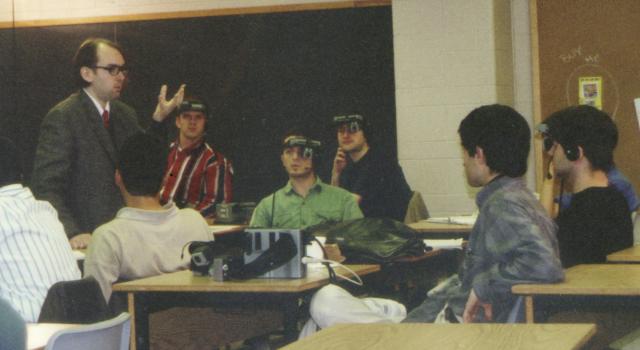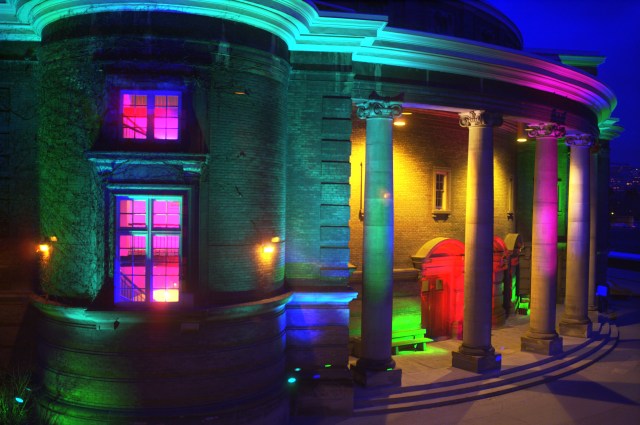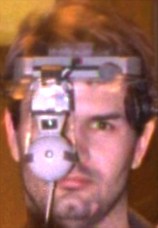ECE 1766 Personal Imaging and Photoquantigraphic Image Processing
Starts Wednesday September 16, 11am
GB 404 (Galbraith Building, 4th floor)
Wednesdays 11am to 1pm
Prof. Mann wearing an embodiment of
his WearComp invention with EyeTap camera system
built into what look like just like ordinary bifocal eyeglasses presents
a lecture to his ECE1766 class of photographic cyborgs:

ECE1766 final course project of the 1998 ECE1766 class;
collaborative computer-mediated reality environment:

 1998 Student Graham Chubb with Reality Mediator
1998 Student Graham Chubb with Reality Mediator
(each student in class had the opportunity to design and build a reality
mediator like this one)
Course WWW page:
http://wearcam.org/ece1766.html
or
http://hi.eecg.toronto.edu/ece1766.html
or
just follow the link from wearcam.org
ECE 1766 exists within
the new field
of Personal Imaging, at
the boundary of
photo-image processing,
computer graphics, machine vision,
and humanistic intelligence.
This course will take the student beyond traditional "classroom thinking".
To guage your preparedness for this kind of thinking, ask yourself:
"do I think scientifically outside the classroom or lab?".
Do you apply science to real life? ("Art, science, or technology
that becomes an entity apart from everyday life is a lifeless parody
of itself")
The course will be hard work but extremely rewarding, and will give you the
opportunity to become one of the world's first "cyborgs", and to touch the
frontier of human achievement in this new field of research
(ECE1766 being the first course in the world in this new field).
Thus there is a tremendous opportunity for theses, future work,
and a chance to have a large impact on the world, within
the context of a very rewarding learning experience.
Because of the greater opportunity for personal involvement than many other
courses offer (e.g. the chance to become one of the world's first cyborgs
and learn by not just doing, but "learn by being"), the course will be of
lesser benefit to those who just audit, and greater benefit to those who
participate fully. The "learn by being" paradigm is perhaps one of the
strongest learning paradigms, beyond just "learning by doing".
Prerequisites:
-
an inquisitive mind (many new electrical, optical, etc. inventions will
be presented)
-
imagination (willingness to suspend disbelief)
-
mathimagination: pure math = thinking outside the box of applied math
-
not being squeamish or afraid of messy wiring, electric circuits, etc.
-
some degree of computer literacy; software you should know or learn:
-
linux and X (XFree86)
-
c
-
matlab running under unix (linux) environment
-
gimp (gnu image manipulation program)
Materials you should have access to:
- A PC with Linux or a UNIX workstation with Xwindows,
to which you can access a serial port.
- Access to Matlab, or one of the freeware equivalents.
- Basic tools of engineering, as might be needed to make
various circuits and related prototypes.
List of topics addressed:
-
cultural engineering: critical thinking, interrogative art, the camera
as a protective element, and philosophical background for personal imaging;
readings: turning the tables on video surveillance; ShootingBack:
http://wearcam.org/shootingback.html
-
introduction to programming environment:
reading:
USENIX98 closing keynote
http://wearcam.org/usenix98/index.html;
note on universal accessibility of knowledge;
reading:
http://www.gnu.org/philosophy/philosophy.html
-
camera viewfinders: the WearCam invention, its optical principle of operation
assignment: viewfinders
-
algebraic projective geometry and video orbits
-
shooting exercise:
creating orbits of the projective group of coordinate transformations in video
-
using the video orbits software package to make image composites
-
photoquantigraphic imaging:
extending dynamic range by combining differently exposed images
-
shooting exercise: taking multiple pictures that differ only in exposure
-
photoquantigraphic image processing programming exercise:
extending dynamic range by combining two differently exposed pictures
-
lightvectors and lightspaces
-
the lock-in camera (video of FT623 and of dual 15hz lamp illuminated scene)
-
programming exercise: image processing in lightspace
-
nerd kits (geekwear, geekware): on being a photoborg; getting started with
personal imaging in the linux and X environment.
-
the covert nerd kit
-
shooting candid "lookpaintings"
(http://wearcam.org/orbits/index.html)
-
life through the screen:
the reality user interface, the Reality Window Manager (RWM), and telepoint
-
designing a reality user interface for wearcam:
from point and shoot to look and think.
-
internet LightPaintball: an interactive virtual light realty-based game
of the early 1980s (updated variations will now be possible with newer
technology).
-
flashback quake (lightning doom): shooting virtual characters with a real
2.4 kilojoule electronic flashlamp in real corridors and stairwells;
a picture's worth a thousand rounds of ammo
-
wristcam (wrist watch computer running Linux 2.0 and XFree86 X windows)
-
wristcam programming exercise: oclock; transparent, thin border, xor,...
-
inventing the camera of the future
This is a grad course, but there are a few spots open as
4th year undergraduate electives.
This course would be particularly suited to the diverse
and scientific mindset of the 4th year Eng. Sci. students.
ENG. SCI. or electrical and computer engineering UNDERGRADS:
You could be assimilated;
Become the world's first "cyborgs", be a camera, and experience a
new approach to intelligent signal processing
and image processing.
ECE 1766 (Personal Imaging, Photoquantigraphic Image Processing, etc.)
Starts Wednesday September 16, 11am
GB 404 (Galbraith Building, 4th floor)
Wednesdays 11am to 1pm


 1998 Student Graham Chubb with Reality Mediator
1998 Student Graham Chubb with Reality Mediator